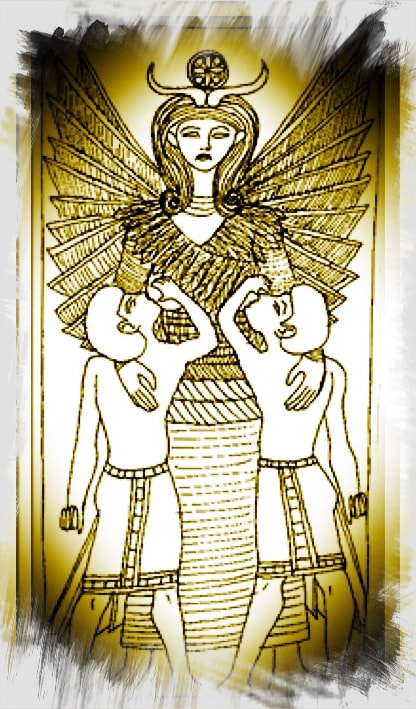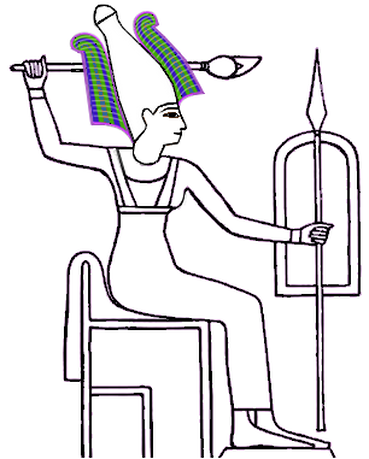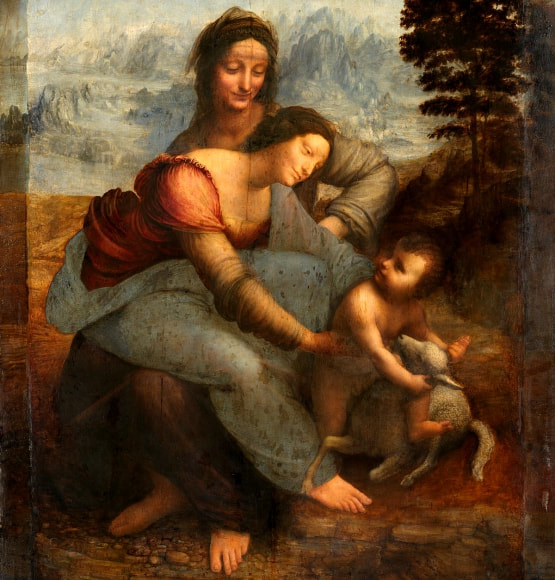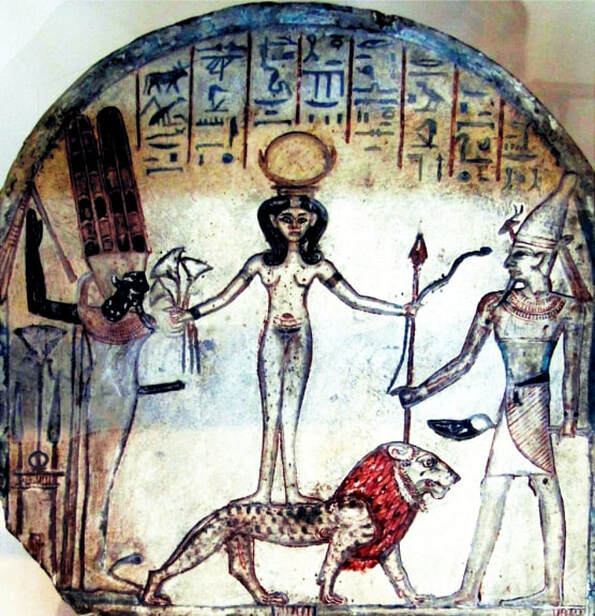From
Did God Have a Wife?
by Professor William G. Dever
Did God Have a Wife?
by Professor William G. Dever
|
|
Early Israelite culture cannot be separated easily from the culture of “Canaan” - Mark S. Smith
...Israelite religion, however distinctive it finally became (as in later Judaism), grew out of Canaanite religion, not, as biblical propagandists claimed, in opposition to it - William G. Dever |
|
|
|
Overview
Professor Dever's thesis is that from the earliest periods of Israelite history, there was a sharp divide between the mass of rural village dwellers and the few self-appointed dignitaries and authorities in the city, the latter considered corrupt by the mass of humble peasants in the far flung hamlets and villages. The official form of Judaism, established by the priests in Jerusalem, meant little to the mass of Israelites and Jews, whose beliefs, daily rites and traditions derived almost entirely from the early Canaanites who first inhabited the lands of Syria, Palestine and Israel. In short, the religious beliefs of the larger demographic differed drastically from the few wealthy city-dwellers responsible for orthodox Judaism. This is pivotal for the advent and legitimacy of Judaism's so-called "monotheism," a dogmatic paradigm forced on the people who would never have freely chosen it for themselves. Asherah & Other Goddesses Dever succinctly informs his readers about early Canaanite and Phoenician deities who were also worshiped for centuries by the early Israelites and Jews. This is particularly the case with Canaanite-Phoenician goddesses, such as Asherah, Kadesh, Anat, Astarte and others. He lists 150 goddesses that were finally excised from the Jewish pantheon, as the worship of Yahweh rose to ascendancy - WD
The God Before Jehovah Dever shows that Yahweh (or Jehovah) coalesced out of several previous deities, primarily El, or as he was also know Ba'al. El had many appellations and manifestations. A great many of the symbols later considered Israelite derive from his cult. Elohim Devers emphasizes that before the advent of Jehovah, the single patriarchal deity, the scriptures speak of many gods. Certain important texts use the term Elohim, which is plural as well as feminine. The term may not be originally Hebrew at all. Therefore, passages in Genesis and Exodus which speak of the many gods, may allude to deities worshiped long before the existence of the Jews. Political Correctness Dever strongly deplores the political correctness of many modern archaeologists, ethnologists and anthropologists working to distort the truth about early Israelite history. They seem determined to obliterate the history of the Canaanites, treating them as if they were purely fictional. This travesty - perpetrated from the highest positions of academia - muddles pre-Israelite history and obscures details pertaining to the goddess tradition. This unwarranted and scurrilous attempt to scrub history is prompted in large part by pre-Israelite accounts of the role of women and their tutelary goddesses. Thanks to political correctness and chauvinist feminist narratives, the history of Canaan and Israel as recorded by male scholars and experts is presently under attack and grossly defaced. (See more below...) |
|
|
|
Daughter of Asherah, the goddess Anat was known as the "Lion Lady." Like her mother and other goddesses she was worshiped by early Israelites and Jews, particularly in the small rural settlements. Anat was the over-sexed consort of Ba'al - the "whore" of God who apparently appears in disguised form in the Book of Revelation. Some epithets and traits of her mother Asherah were later transferred to her, Hence, beyond Syria she was known as Astarte and Ashtaroth. Anat or Anath may also be identical with Tanit or Tanith of the Phoenicians and Astar and Neith of the Egyptians. She appears as the Grecian Athena. She was a goddess/patron of weapons and war. In ancient iconography the shield was her main symbol. Her color was red. (Consider the patronym Rothschild.) Interestingly, the city of the ancient Levites just happened to be called Ashtartu, dedicated to the goddess. One of Astarte's main titles was "Lady of the two horns."
|
|
|
|
Asherah and her daughter Anat appear in disguised form as St. Anne and the Virgin Mary. Leonardo da Vinci has Mary sitting in Anne's lap. Like Asherah and Anat, they are in the guise of wet-nurses of their young son-lovers - Jesus and John. Asherah may precede the Canaanites, as the goddess Ashratum of the Amorites, with her male consort Anu being equivalent to the Canaanite El, who was finally transmogrified into Yahweh or Jehovah. The Phoenicians knew her as Elath. Amorite kings bore titles such as "slaves of Asherah." Originally, a statue of Asherah was included in the Temple of Jerusalem, built as it was not by Jews but Phoenicians. She was worshiped in Arabia under the name Atharath, in Babylon as Astarte, and in Sumeria as Inanna-Ishtar. Her western antetype is Ostara, after which we get the term Easter.
The figure of Asherah did not continue by name in the Phoenician world, and Astarte may have been the bearer of some features earlier associated with Asherah. To be sure, some scholars510 have argued that the goddess Tannit may have been the Phoenician-Punic descendant of Canaanite Asherah or included her features, including the titles - Mark S. Smith (The Early History of God) |
|
.
|
|
...the Hebrew Bible is not an adequate source in itself for reconstructing a reliable portrait of Israelite religions as they actually were - William Devers
|
|
|
|
Canaan?
In the last decade or so, however, the terms "Canaan" and "Canaanite" have come under concerted attack, not only from radical "revisionists," but also from mainstream biblical and ancient Near Eastern scholars. Israelite religion, however distinctive it finally became (as in later Judaism), grew out of Canaanite religion, not, as biblical propagandists claimed, in opposition to it.
The role of Yahweh within Israelite religion was an important area of inquiry within biblical studies throughout most of the twentieth century. During this century, the understanding of Yahweh has been shaped strongly by the study of Canaanite deities - Mark S. Smith (The Early History of God: Yahweh and the Other Deities in Ancient Israel) The Temple The biblical text itself acknowledges that the "Israelite" tripartite temple was really Phoenician in design, designed by Phoenician architects and built by Phoenician craftsmen and artisans (I Kings 5:1-12 & 7:13-14). Why Religion? I suggest that for the ancients the threat derived from the perception that the universe was not "friendly." It was disordered, chaotic, fundamentally dangerous, if not evil. Israelite Religion Israelites could not comfort themselves with the much later (and non-Semitic) notion of the "immortality of the soul." When the body died, that was the end.
In the Hebrew Bible there is only a hint of belief in an "afterlife..." ...the notion of "the immortality of the soul" (a Greek idea) is very late... No Word for Religion Religion was so taken for granted that biblical Hebrew, brew, for instance, has no specific word for "religion." Living in antiquity was being "religious." The modern, idealistic, romantic portrait of ancient Israelite religion is a comfortable delusion, but one that obscures the reality. Canaanite Origins of Yahweh (El) Several specific epithets are shared by Canaanite Baal and Israelite Yahweh. "El, the One of the mountains." Many deities in the ancient Near East are associated quite naturally with mountains. ...the Hebrew term shad, "mountain," derives from earlier West Semitic thad, "breast." "El-Shadday," "the one of the mountains," was thus probably conceived of in pre-Israelite religion as the old Amorite-Canaanite storm god, associated with the awesome (and procreative) powers of nature.
...in the Pentateuch, it is the Canaanite deity El who regularly appears, not Yahweh. While they themselves were orthodox monotheists, looking back at much earlier times from that perspective, they candidly acknowledge that the "god of the fathers" was Canaanite El, not their own deity Yahweh. the Hebrew Bible, despite its monotheistic biases, preserves the old Canaanite name El for the Israelite deity, and even uses it in the plural. Several Psalms, such as Psalm 65 (below), invoke the "storm god" imagery of Canaanite Baal, who brings back the rain upon his return from the underworld, and they transfer this imagery to Yahweh.
The worship of Yahweh thus easily merged into, complemented, or supplanted that of the Canaanite male gods - Raphael Patai (The Hebrew Goddess) The Elohim The dead are sometimes called elohim, "the gods," as though the deceased were now with the gods somewhere. ...the very first words of the Hebrew Bible are "When God began to create the heavens and the earth." ...the notion of a multiplicity of deities sitting together in council - so typical of the Canaanite pantheon and its functions - is taken for granted in the Hebrew Bible, even after Yahweh is said to have come into his ascendancy. That is why the First Commandment is phrased the way it is: "You shall have no other gods before [or `besides'] me" (Exodus 20:3). One could have other gods; and many, if not most, ancient Israelites did have. For that reason, most scholars today regard Israel's faith not as monotheism, but rather as "monolatry." This is the acknowledgment of other gods, but the worship of only one of them, in this case, Yahweh, the supreme deity. Where Israel Came From ..."Israel" as a distinctive people and soon-to-be be nation appear in the full light of history only here, in the Iron Age of ancient Palestine. Israel's Geography ...we are dealing with an area west of the Jordan River that is about the size of the state of New Jersey. It is only 250 miles long, the southern half barren desert, and varies from about 30 to 70 miles wide. Israel looms "larger than life" in our Western imagination because of its spiritual significance, but it was a tiny country. The entire population in the Iron Age never exceeded about 150,000 (today it is some ten million in a comparable area). The few large cities cannot have contained more than about 3,000 people; and an average town would have had a population of only some 500-1,000; and most areas were rural, with a very low population density. Jerusalem in the time of Solomon had perhaps 2,000 people, and at its height in the 8th century B.C. it probably had no more than 5,000 people. Early Israel was exclusively rural: village, hamlets, and a few isolated homesteads. Of the 300 or so 12th-lath-century B.C. Israelite sites that are currently known, none had a population of more than 300, and most had fewer than 100. None was a town, much less a city, by any criteria. A total population of about 50,000 (12th century B.C.) to 75,000 (11th century B.C.) was widely dispersed over the countryside, concentrated mostly in the central hills, stretching from Galilee, through Samaria maria and Judea and into the northern Negev.
Not only was Israel insignificant in size, it was also vulnerable because cause of its geopolitical situation. It was a small coastal strip along the bend of the Fertile Crescent, sandwiched in between the great empires of Egypt and Mesopotamia. It lagged far behind them in all the early advances of civilization. More significantly, because of its exposed position as a "land bridge" between Africa and Asia, Palestine and later Israel were frequently trampled over, subjugated, and occupied for long periods by foreign powers. Think of the long succession of peoples who have overrun this general area along the Levantine coast in historical times: Amorites, Hittites, Hurrians, Egyptians, Philistines, Assyrians, Babylonians, Persians, Greeks, Romans, Muslims, European Crusaders, Turks...
No single political entity ever ruled the area in antiquity for more than about 400 years. By the mid-late 10th century BC, in the "Age of Solomon;" when the population may have reached some 100,000, there were about 20 "towns" by suitable local criteria, that is, centers with a population of 500-1,000. There may have been a few real cities, with up to 2,000 people. The latter might have totaled some 5,000 people in all, or roughly the five percent urban population that I suggested above...the bulk of the population remained rural, as recent studies have shown. The urban elites who wrote and edited the Hebrew Bible cannot possibly have constituted more than a tiny fraction of one percent, isolated from and largely alienated from the vast majority - WD How "representative" were they when they spoke of religion? Inhospitable Climes Israel suffered from a lack of any natural resources that could have brought it trade, financial independence, or prosperity. The land is a geologist's ideal field laboratory, fascinating in its diversity, but it is a mostly hostile environment for human man habitation. The southern deserts were uninhabitable except for brief periods when complex technology made runoff irrigation possible, as in Roman-Nabataean times; or when the wilderness provided a desperate retreat, treat, as for Byzantine monks. The point here is that Israel's "fractured geography" meant that for most of the time its society and political structure were "fractured" as well. In addition to poor, thin, rocky soils, even in the best of areas, there was the problem of water. There are no real rivers except the Jordan, and that ran in a channel so deep that the waters were largely inaccessible and emptied uselessly into the Dead Sea. Elsewhere there are few perennial springs, and primitive technology could not manage deep wells. ...crops even in prime agricultural areas often fail. Finally, even in years of bountiful harvests, as much as a third of the grain crop could not be adequately stored and was lost to dampness, rot, and vermin. Mining Copper ore had been mined in the southern Negev desert and the Jordan Valley from the third millennium on; but the mines are isolated, in the blistering desert, far from sources for the charcoal needed for smelting. There are some iron deposits in Transjordan, but iron technology was primitive and inefficient, even in the "Iron Age." Nowhere are there deposits of gold, silver, precious stones, or even other useful minerals. Natural Resources Ancient Palestine's poor natural environment, precarious geopolitical situation, unreliable subsistence, fractured social structure, and political instability mean that we must keep constantly in mind one fact. Ancient Israel was a truly marginal economy and society. The country was always poor compared to its prosperous neighbors; always powerless compared pared to their might; always on the verge of extinction (as finally happened). It may be unsettling to some readers, but the fact is that ancient Israel was an obscure cultural and historical backwater of the ancient Near East. If arable land and available water were scant, other natural resources were almost nonexistent. There was timber in the upland areas, but much of the land had already been deforested by Israelite times (the process began with the first villages in the Neolithic period, ca. 8,000 B.c.).
It would have been long forgotten except for its one memorable contribution to civilization
United Monarchy Palestine first achieved statehood only with the United Monarchy of Israel, ca. 1000 B.C.
Disunity Prevails ...within a century this nascent union had split into the northern kingdom of Israel and the smaller southern kingdom of Judah. The north was more prosperous, but it was riven by old tribal rivals and was unstable from the beginning. The south, often involved in civil war with the north, survived longer under the Davidic dynasty. The political history of both Israel and Judah was "nasty, brutish, and short," as the saying goes, characterized by dissension, treachery, corruption, frequent bloody assassinations, and ultimately the failure to create a viable state. Overall life expectancy was only about 30 years, probably less for women. The Reality The majority of ancient Israelites were essentially subsistence farmers eking out a miserable existence on small plots of land. Most people were thus removed from the centers of political power, religious authority, and international tensions, insulated from the decision-making processes that shaped national culture. They would have known somehow that they were "Israelites," but they didn't carry passports. ports. And the orthodox religious ideals enshrined in the Hebrew Bible would have been foreign to them throughout most of Israel's history, at least until the Deuteronomistic reforms The few true elites were probably found among a few large landholders and in Jerusalem, in court and priestly circles (those who wrote the Bible).
Literacy Even priests and kings could not read and depended pended on a small cadre of professional scribes to communicate and to carry on their affairs. In ancient Israel, our earliest Hebrew inscriptions come from the settlement horizon,the 11th-12th centuries BC. ...writing does not become widespread before the 8th century BC. ...a number of people could write their names, numbers, and the names of a few commodities. But that is a far cry from being truly literate, ate, able to read literary material such as we have in the books of the Hebrew brew Bible. It has been estimated that even in the Roman period, no more than 5 percent of the population was literate by the above definition. In ancient Israel the figure was certainly lower. That has important implications for the question I have raised here concerning how early the Hebrew Bible could in fact have been written, and whether ordinary people could have read it if they had had it - WD Non-Existent Regional Knowledge Yet it is clear that most ancient Israelites knew these peoples only by hearsay, and may even have regarded them as largely fictional. A few adventurers and traders may have ventured abroad, but no one else. Even the biblical authors, who deal with these various peoples in writing, had little direct contact with them.
Pagan Elements ...it would be surprising if the Israelite cults had not been influenced by these cults of the wider ancient Near Eastern world. Downplaying Pagan Elements Works of Old Testament theology, not surprisingly (Chapter II), have downplayed or even denied the existence of magic in ancient Israel. The Phoenicians were not only the contemporary Iron Age descendants of the Canaanites and heirs of their long civilization, but they were now despised foreigners who worshiped Baal, not Israelite Yahweh. High Places & Standing Stones ...the standing stones, reminiscent of the old Canaanite cults, are finally prohibited by the 7th-century BC reform movements. But they had always been in use in folk religion, and they continued to be. Asherah The cult of the Goddess Asherah continued among the Hebrews throughout the periods of the judges and the kings - Raphael Patai (The Hebrew Goddess) The Goddess Asherah was worshiped in Israel from the days of the first settlement in Canaan, the Hebrews having taken over the cult of this great mother goddess from the Canaanites - ibid The reluctance and the tardiness of mainstream biblical scholarship in recognizing that there was a "cult of Asherah" in ancient Israel are due, I think, to several factors. Asherah, almost forgotten over the centuries, reemerged and could once again be seen as the principal pal female deity of the pantheon in Canaan in pre-Israelite times. She appears at Ugarit (North-Eastern Syria) as the consort of the chief male deity El, the "Father of Years." Asherah, long venerated in Canaan as patroness of mothers. "She who treads/subdues Sea," the sea being seen in antiquity as the source of deep, mysterious, deadly powers. But whatever her name means, her usual titles are "Lady Asherah" and "Mother of the Gods." She is thus a sort of venerable matron, one who often intercedes with her husband El on behalf of the younger deities - especially Baal and his consort Anat (who are ferocious lovers and rivals of the older pair).
Anat & Asherah Canaanite Anat, the fierce warrior and courtesan, was largely forgotten by Israelite times. But Lady Asherah, the nurturing Mother Goddess, was remembered and venerated, at least in some circles. I am suggesting tentatively that the female figurines were connected principally though not exclusively with reproduction, but that they were not "votives" in the usual sense of that term. They are better understood as images representing the goddess Asherah, used as talismans to secure her favors. Tree Symbolism Asherah, her tree symbolism, and high places with altars in groves of trees were all held to be typical of Canaanite "fertility" cults and were thus anathema to the biblical writers. Sacred Prostitution Classical writers like Herodotus wrote describing how women in Babylon were compelled at least once in Temple of Aphrodite and solicit a man to engage in sexual intercourse. The reference to "male cult prostitutes" (II Kings 23:7; RSV) housed in (or around) the Temple is problematic and has been the subject of heated discussion.
I believe that men also participated in religious practices of which the canonical biblical writers disapproved. Child Sacrifice Details in several texts, however, such as II Kings 23:10 and Jeremiah 32:35, ring true in the light of what we now know. In both passages, the sacrifice of children in Jerusalem is said to have taken place at a site called "Topheth," in the Valley of Hinnom below the Temple mount. And the god to whom the children were sacrificed as a burnt offering is specified as "Molech." A god called Molech is known from some Canaanite and especially from later Phoenician sources, the latter partly contemporary with monarchic Israel. Phoenician and later Punic votive inscriptions actually describe a sacrifice of children called a mulk. like Diodorus Siculus, Philo Byblius, and Kleitarchos give horrifying accounts of a great bronze statue of the god Kronos, in whose outstretched arms children were placed over a fire.
Later Prohibition & Suppression The striking "sexual imagery" in Hosea, often connected with trees, is especially telling. Hosea 4:12,13 condemns those who "inquire of a thing of wood," who sacrifice "under oak, poplar, and terebinth, because their shade is good," and thus "play the harlot." You shall not plant any tree as an Asherah beside the altar of Yahweh which you shall make (Deut 16:12). Mosaic Judaism There probably was a historical Moses, who introduced the desert deity Yahweh to tribal groups in the Sinai. And "Mosaic" traditions may have lingered, at least orally, throughout the monarchy,, even in folk religion. But the promotion of Moses to the position of "founder of Israelite religion;" the elevation of "law" to a preeminent position, is almost certainly the product of the 7th-6th century BC Deuteronomistic theological agenda. These are all late theological and literary constructs propagated by extremists toward the very end of the monarchy - right-wing, orthodox, nationalist parties. Ten Commandments Even the "Ten Commandments" in their present form were probably peripheral to most people's lives, along with the "Sinai" and "Mosaic covenant." Monotheism I have suggested, along with most scholars, that the emergence of monotheism - of exclusive Yahwism - was largely a response to the tragic experience of the exile. It was, in effect, a "rationalization" of defeat, an attempt tempt to forge a new identity and destiny for a people who otherwise would have been left without hope. Thus there came into being the "New Israel" envisioned by the later prophets, Jeremiah, Ezekiel, and especially Second Isaiah. |
|



